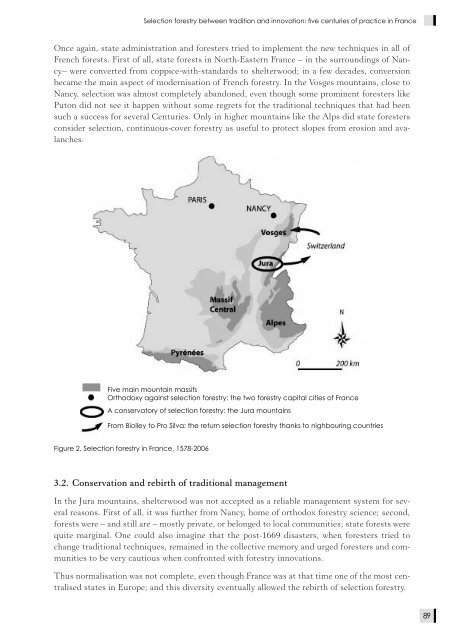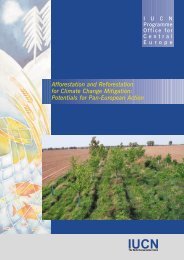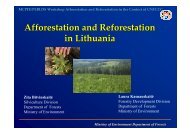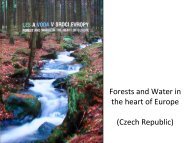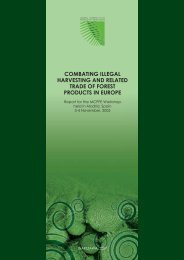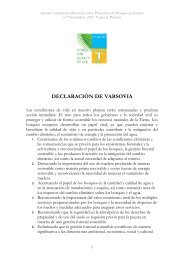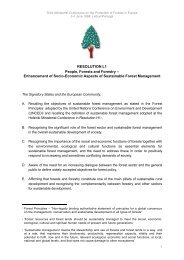- Page 2 and 3:
CULTURAL HERITAGE AND SUSTAINABLE F
- Page 4 and 5:
VOLUME 1. CONTENTS PREFACE MCPFE Li
- Page 6 and 7:
CONTENTS Landscape dynamics of the
- Page 8 and 9:
PREFACE The International Conferenc
- Page 10 and 11:
INTRODUCTION Mauro Agnoletti 1 This
- Page 12 and 13:
INTRODUCTION nifi cant. In the view
- Page 14 and 15:
KEYNOTE PRESENTATIONS
- Page 16 and 17:
18 KEYNOTE PRESENTATIONS whom fores
- Page 18 and 19:
20 KEYNOTE PRESENTATIONS management
- Page 20 and 21:
22 KEYNOTE PRESENTATIONS 3 1 4 7 6
- Page 22 and 23:
24 KEYNOTE PRESENTATIONS and its cu
- Page 24 and 25:
26 The European Landscape Conventio
- Page 26 and 27:
28 KEYNOTE PRESENTATIONS sponsibili
- Page 28 and 29:
30 KEYNOTE PRESENTATIONS 2.2.2. Geo
- Page 30 and 31:
32 KEYNOTE PRESENTATIONS The Contra
- Page 32 and 33:
34 KEYNOTE PRESENTATIONS 4. Impleme
- Page 34 and 35: 36 KEYNOTE PRESENTATIONS 4.2.2. Nat
- Page 36 and 37: 38 Traditional Knowledge World Bank
- Page 38 and 39: 40 KEYNOTE PRESENTATIONS they will
- Page 40 and 41: 42 KEYNOTE PRESENTATIONS technology
- Page 42 and 43: Theme 1. HISTORY OF TRADITIONAL FOR
- Page 44 and 45: 48 Traditional forest management un
- Page 46 and 47: 50 Theme 1. HISTORY OF TRADITIONAL
- Page 48 and 49: 52 Theme 1. HISTORY OF TRADITIONAL
- Page 50 and 51: 54 Theme 1. HISTORY OF TRADITIONAL
- Page 52 and 53: 56 La scomparsa dell’utilizzazion
- Page 54 and 55: 58 Theme 1. HISTORY OF TRADITIONAL
- Page 56 and 57: 60 Theme 1. HISTORY OF TRADITIONAL
- Page 58 and 59: 62 Theme 1. HISTORY OF TRADITIONAL
- Page 60 and 61: 64 Theme 1. HISTORY OF TRADITIONAL
- Page 62 and 63: 66 Theme 1. HISTORY OF TRADITIONAL
- Page 64 and 65: 68 Theme 1. HISTORY OF TRADITIONAL
- Page 66 and 67: 70 Theme 1. HISTORY OF TRADITIONAL
- Page 68 and 69: 72 Theme 1. HISTORY OF TRADITIONAL
- Page 70 and 71: 74 Theme 1. HISTORY OF TRADITIONAL
- Page 72 and 73: 76 Theme 1. HISTORY OF TRADITIONAL
- Page 74 and 75: 78 History and Refi nement of TFK:
- Page 76 and 77: 80 Theme 1. HISTORY OF TRADITIONAL
- Page 78 and 79: 82 Theme 1. HISTORY OF TRADITIONAL
- Page 80 and 81: 84 Theme 1. HISTORY OF TRADITIONAL
- Page 82 and 83: 86 Theme 1. HISTORY OF TRADITIONAL
- Page 86 and 87: 90 Theme 1. HISTORY OF TRADITIONAL
- Page 88 and 89: 92 Indigenous Infl uence on Forest
- Page 90 and 91: 94 Theme 1. HISTORY OF TRADITIONAL
- Page 92 and 93: 96 Theme 1. HISTORY OF TRADITIONAL
- Page 94 and 95: 98 Theme 1. HISTORY OF TRADITIONAL
- Page 96 and 97: 100 Koguryo civilisation sustained
- Page 98 and 99: 102 Theme 1. HISTORY OF TRADITIONAL
- Page 100 and 101: 104 Theme 1. HISTORY OF TRADITIONAL
- Page 102 and 103: 106 Theme 1. HISTORY OF TRADITIONAL
- Page 104 and 105: The uses of forests and woodlands i
- Page 106 and 107: Table 3. Main changes of use and pr
- Page 108 and 109: 2.4. Expansion of haciendas From th
- Page 110 and 111: East, Siberia, and the North (reind
- Page 112 and 113: Current status and problems with tr
- Page 114 and 115: Current status and problems with tr
- Page 116 and 117: Confl icts between traditional know
- Page 118 and 119: Confl icts between traditional know
- Page 120 and 121: Confl icts between traditional know
- Page 122 and 123: Confl icts between traditional know
- Page 124 and 125: It all began with Adam The historic
- Page 126 and 127: capitalist society and rural commun
- Page 128 and 129: 5. Conclusions: readapting to new e
- Page 130 and 131: Evolution of the forest landscapes
- Page 132 and 133: Gli stessi tecnici e la Pubblica Am
- Page 134 and 135:
Richerche sperimentali per una gest
- Page 136 and 137:
Indice di diversità (Shannon) 5 4
- Page 138 and 139:
Lo studio, inoltre, evidenzia l’i
- Page 140 and 141:
Cultural forest landscapes and ecol
- Page 142 and 143:
If human infl uence remains in the
- Page 144 and 145:
ing animals under control and haste
- Page 146 and 147:
sensations that are highly diverse
- Page 148 and 149:
The “Confl ict” between Traditi
- Page 150 and 151:
The “Confl ict” between Traditi
- Page 152 and 153:
The “Confl ict” between Traditi
- Page 154 and 155:
The “Confl ict” between Traditi
- Page 156 and 157:
The “Confl ict” between Traditi
- Page 158 and 159:
Problems with the practical impleme
- Page 160 and 161:
Biocultural heritage - the missing
- Page 162 and 163:
Studying land use history to suppor
- Page 164 and 165:
autore che pertanto può venire con
- Page 166 and 167:
3. Roccolo The main bird-catching s
- Page 168 and 169:
fra di loro di 40-50 cm. I suddetti
- Page 170 and 171:
The role of pine forests for shapin
- Page 172 and 173:
2.2. Pine Trees Developed into a Sy
- Page 174 and 175:
can astronomic scientist’s photog
- Page 176 and 177:
Restoration of selected beech coppi
- Page 178 and 179:
Diffi culty in shoot selection and
- Page 180 and 181:
In practice we have to manage in di
- Page 182 and 183:
diameter of the stands (Figure 1.).
- Page 184 and 185:
10. References Restoration of selec
- Page 186 and 187:
Getting to living cultural landscap
- Page 188 and 189:
Meeting the challenges of preservin
- Page 190 and 191:
Figure 1. The network of tratturi,
- Page 192 and 193:
The forest landscape of transhumanc
- Page 194 and 195:
Scottish upland forests: History le
- Page 196 and 197:
Scottish upland forests: History le
- Page 198 and 199:
Figure 4. Gordon map Showing open w
- Page 200 and 201:
2. Discussion The increase in numbe
- Page 202 and 203:
Working landscapes or recreational
- Page 204 and 205:
North America; with differences in
- Page 206 and 207:
temporary (50-150 years) economic m
- Page 208 and 209:
5. Acknowledgements Research collea
- Page 210 and 211:
European Landscapes and Forests as
- Page 212 and 213:
European Landscapes and Forests as
- Page 214 and 215:
spiritual, and mystical values. Con
- Page 216 and 217:
management, which are subsidiary to
- Page 218 and 219:
Theme 4. EUROPEAN INITIATIVES FOR T
- Page 220 and 221:
228 Theme 4. EUROPEAN INITIATIVES F
- Page 222 and 223:
230 Theme 4. EUROPEAN INITIATIVES F
- Page 224 and 225:
232 Theme 4. EUROPEAN INITIATIVES F
- Page 226 and 227:
234 Theme 4. EUROPEAN INITIATIVES F
- Page 228 and 229:
236 Theme 4. EUROPEAN INITIATIVES F
- Page 230 and 231:
238 Theme 4. EUROPEAN INITIATIVES F
- Page 232 and 233:
240 Theme 4. EUROPEAN INITIATIVES F
- Page 234 and 235:
242 Theme 4. EUROPEAN INITIATIVES F
- Page 236 and 237:
244 Theme 4. EUROPEAN INITIATIVES F
- Page 238 and 239:
246 Theme 4. EUROPEAN INITIATIVES F
- Page 240 and 241:
248 Theme 4. EUROPEAN INITIATIVES F
- Page 242 and 243:
250 “Forest + Culture” in Austr
- Page 244 and 245:
252 Theme 4. EUROPEAN INITIATIVES F
- Page 246 and 247:
254 Theme 4. EUROPEAN INITIATIVES F
- Page 248 and 249:
256 Hidden heritage in Dutch forest
- Page 250 and 251:
258 Theme 4. EUROPEAN INITIATIVES F
- Page 252 and 253:
260 Cultural re-animation and rural
- Page 254 and 255:
262 Theme 4. EUROPEAN INITIATIVES F
- Page 256 and 257:
264 Theme 4. EUROPEAN INITIATIVES F
- Page 258 and 259:
266 Theme 4. EUROPEAN INITIATIVES F
- Page 260 and 261:
268 Forest landscape cultural herit
- Page 262 and 263:
270 Theme 4. EUROPEAN INITIATIVES F


